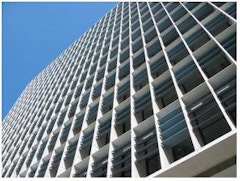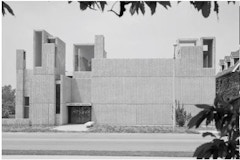22 results
-
Sealed indoor environments have created artificial, homogeneous ecosystems that sever ties between humans and the natural world. This paper…
-

Pioneering the Structural Terracotta Mullion Façade
- Paper by Victoria Ereskina, Façade Design Professional John Neary, Sr. Façade Specialist
Architects today must explore alternative enclosure materials to meet evolving energy codes and embodied carbon regulations. Terra cotta has been… -

Lithic Revival
- Paper by Alex Terzich,
The recently completed Capital One Hall performing arts center located in the Washington DC metro area is defined by a pleated exterior of glass and… -

Structural Silicone Glazing
- Paper by Jon Kimberlain · Yvonne Diaz · Andrew Dunlap · Adrienne Bowman-Grittini
The recent 50 year anniversary of the first use of silicone sealant in a 4-sided structural silicone glazing application marks a sustainable and
-
Facing Density
- Paper by Wendy Cox
The United Nations Department of Economic and Social Affairs projects a world population growth of over three billion over our current, nearly eight
-

The Myth of Simplicity
- Paper by Gerry Lang,
There were good why reasons early US Modernism first evolved in California– wide open sites with no constraints (physical or zoning), and effectively… -
Vertical Louvered Solar Control
- Paper by Clifton Fordham, RA, LEED AP
Exterior shading devices, when typically used, are horizontal planes that are most effective at the south face of buildings in the northern
-
Transformation as Movement
- Paper by Vytenis Gureckas
In 1888 the art historian Heinrich Wölfflin proposed the notion that the primary characteristic of baroque architecture is the illusion of movement.
-
Thinking About Facades
- Paper by Marc Schiler, FASES, LC
There have been three decades of liberating developments in the application of descriptive geometry and freeform design methods, as well as the
-

Teaching Facades
- Paper by Alex Terzich,
As facades become more sophisticated and complex, more detail-intensive and performance-critical, it's vital that architecture students develop a… -

Structuring Skin
- Paper by John Neary,
Curtain wall is the prevailing type of enclosure on modern buildings because of its economy, its independence from structure that allows flexibility… -
Paul Rudolph's Christian Science Building
- Paper by Scott Murray
This paper presents new historical research on the concrete facade of an important but relatively unknown and now demolished building by the American
-

Patchwork
- Paper by Alexander G. Worden, AIA,
It may be difficult for modern man to believe that what is known as handicraft was once the advanced manufacturing of the day. These techniques were… -

Kinetics in Building Facades
- Paper by Sean Cullen · Professor Greg Keeffe
The prominence of climatically responsive building facades through the use of kinetics has proliferated in recent years due to a concern for the
-

Historical Evolution of Responsive Facades
- Paper by Negar Heidari Matin, Ph.D. Candidate, LEED GA · Ali Eydgahi, Ph.D. · Shimming Shyu, Ph.D., RA, LEED AP BD+C · Payam H. Matin, Ph.D.
Responsive facade system is considered a major component of high-performance building envelope that is capable of responding to environmental stimuli
-

Nested Density
- Paper by Wendy Cox, Architect
Projecting imagery onto building facades is not only becoming a marketing necessity for successful urban spectacles but is also altering social urban
-

Autonomous or Appropriate
- Paper by Katrin Terstegen
This paper examines two profoundly different design approaches: one, herein called ‘autonomous’, where the building’s design is governed by internal
-

Developments in Gridshell Design
- Paper by Cristobal Correa P.E., Principal Craig Schwitter P.E., Principal
In 1959 Heinz Isler challenged the world of concrete shell design by proposing a series of shapes for shells that were very different from what most… -

Facade Games
- Paper by James Tice
This paper provides an overview of a course focusing on the façade as taught to architecture students over a twenty-year period. The need for this
-

Air Spaces Changed Everything
- Paper by Gerry Lang, M.Arch., (Penn, 2008), B. Arch (hons., Toronto, 1978) OAA, AIA,TSA, Senior Associate, Leader of Facades Group
This abstract proposes that architectural facade design over the last 60 years has convulsed in light of two disruptions: air spaces which create…



